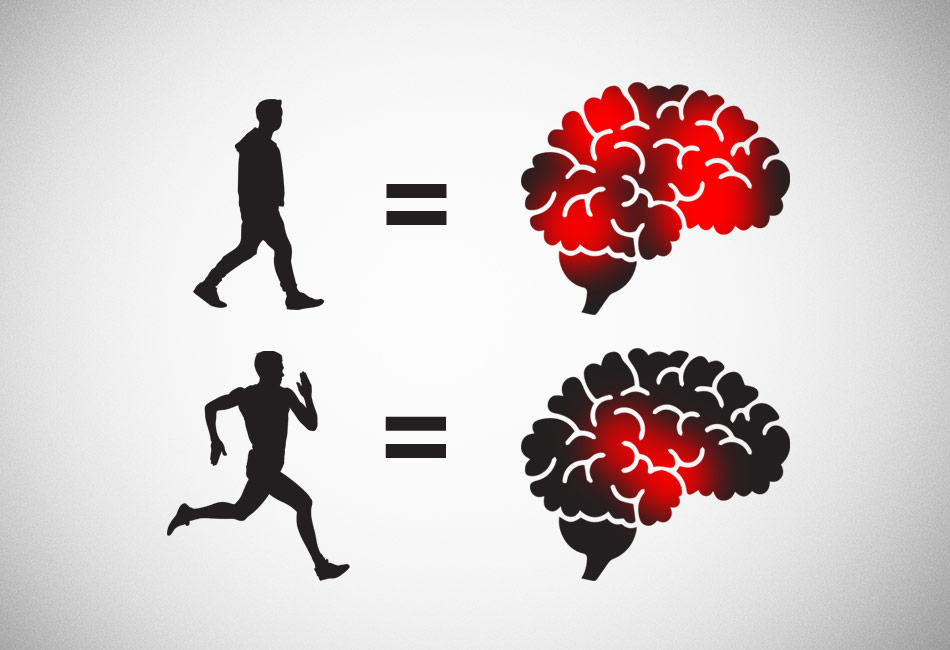Exercise is medicine. It helps the brain get smarter as well as the body get stronger. It improves the brain and it helps in learning and the development of new networks in the brain.
New research[1] coming from the Functional Neuroimaging Group, Department of Radiology, University Hospital Bonn, Bonn, Germany shows us a picture of the brain after low- and high-intensity levels of physical activity, and it is interesting.
The study used twenty-five male athletes who underwent individual assessments using an incremental treadmill test. On separate days they performed low- and high-intensity exercise for 30 minutes each. Before and after exercising, Rs-fMRI was used to examine functional connectivity of different brain regions that are linked to specific behavioral processes. Participants also completed a questionnaire to measure positive and negative mood before and after the exercise.
The results showed that low-intensity physical activity appears to positively affect the brain’s networks that are responsible for cognitive control and attentional processing. Low-intensity exercise like walking or our Wellness workouts boost the brain’s ability to think more clearly and positively affects the amount of focus it can bring to bear on any particular task. This means that after a Tai Chi workout we not only can organize our day better but we are also really good at concentrating on specific things which makes us more productive.
High-intensity physical activity (like HIIT) is best for helping the brain process emotions and strengthen the motor neuron connections between brain and muscles.[2] This has been independently backed up by yet another study[3] that looked at rest state functional connectivity of the sensory network in the brain following hard physical exercise.
Even more interestingly, the mechanism through which all this takes place appears to be due to “neurochemical changes (lactate, cortisol, neurotrophins, neurotransmitters and neuromodulators) that possibly relate to the persistent changes in brain function after acute exercise bouts.” A link that connects brain function, exercise and the complex neurobiological function of the gut microbiome.
What Does It All Mean?
In the plainest English possible the studies show that even light exercise you can do on your sofa while watching TV leads to a refreshing of the brain, clearer thinking and better, more focused attention. The findings transform our Office-friendly workouts into productivity enhancement tools. Taking a walk to help "clear your head" actually does exactly that.
High intensity exercise helps modulate the emotional response which is why punching a heavy bag is such a great way to work out all those ‘issues’. In addition, HIIT work helps create faster reflexes by strengthening the connections of cells in the brain that control the physical movement of the body.
This also impacts those who are coming back to fitness after a long lay-off or are completely new to it. Easing in by picking low intensity exercise to begin with will still deliver results in mind and body despite the fact that it appears to be gentle.
No Excuses
We all have to live life and we all have to work. Exercise seems to make both these things better and more productive. When even the slightest effort has such deep, lasting results it takes relatively little effort to activate the brain’s reward system[4] and form lifelong, positive, life-changing habits.
Sources
- Modulation of Distinct Intrinsic Resting State Brain Networks by Acute Exercise Bouts of Differing Intensity.
- Jiang Z, Wang XF, Kisiel-Sajewicz K, Yan JH, Yue GH. Strengthened functional connectivity in the brain during muscle fatigue. Neuroimage. 2012;60(1):728–3
- Rajab, Ahmad & Crane, David & Middleton, Laura & Robertson, Andrew & Hampson, Michelle & MacIntosh, Bradley. (2014). A single session of exercise increases connectivity in sensorimotor-related brain networks: A resting-state fMRI study in young healthy adults. Frontiers in human neuroscience. 8. 625. 10.3389/fnhum.2014.00625.
- Functional Connectivity of Reward Processing in the Brain, Estela Camara, Antoni Rodriguez-Fornells, and Thomas F. Münte Front Hum Neurosci. 2008; 2: 19. Published online 2009 Jan 16. Prepublished online 2008 Nov 11. doi: 10.3389/neuro.09.019.2008










